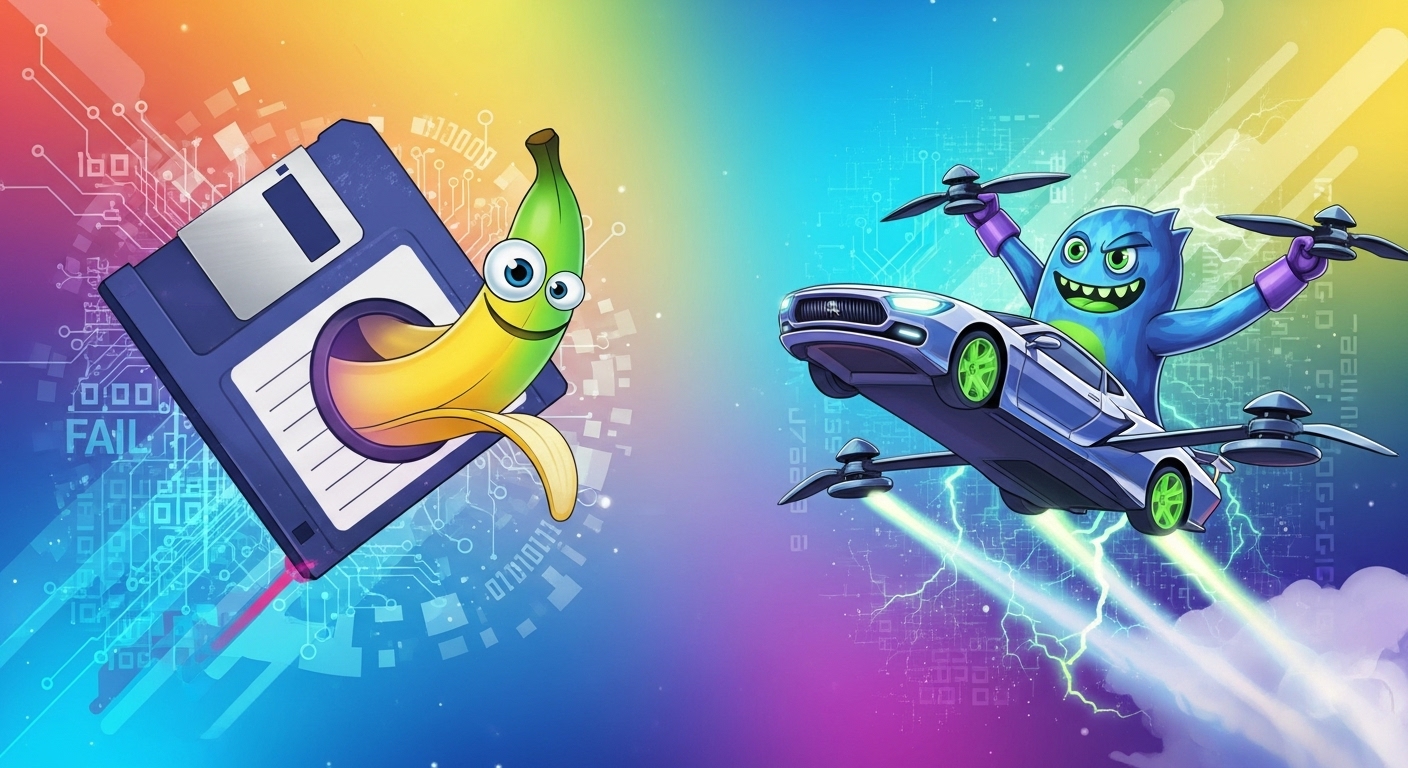Key Takeaways
- Tech history is rich with both spectacular failures and unsung triumphs, many of which shaped the future in unexpected ways.
- Early attempts at innovation often resulted in hilariously impractical designs or concepts that were far ahead of their time.
- Learning from these bizarre tech stories provides valuable insights into the iterative nature of progress and the unpredictable path of technological evolution.
From Floppy Disks to Flying Cars: The Most Hilarious Tech Fails & Triumphs You’ve Never Heard Of
Welcome, fellow digital adventurers, to Nano Banana Monster! Today, we’re not just looking at the sleek gadgets of tomorrow or the powerful software of today. No, we’re taking a delightful detour into the annals of technological history, unearthing the most bizarre, laugh-out-loud fails and the jaw-dropping, unsung triumphs that often get overlooked in the grand narrative of innovation. Forget your common knowledge; we’re diving deep into the quirky corners where brilliance met blunder, and sometimes, blunder accidentally led to brilliance.
Technology’s journey is rarely a straight line. It’s a tangled, winding path filled with groundbreaking successes and equally spectacular, often hilarious, failures. These aren’t just cautionary tales or forgotten footnotes; they’re vital parts of the story, showing us that even the smartest minds can miss the mark, and sometimes, the most unassuming projects can change the world.
The “Oops” Moments: Hilarious Fails You Won’t Believe
We all know about Betamax losing to VHS, or the epic failure of Google Glass to capture the mainstream imagination. But the rabbit hole of tech blunders goes much, much deeper. Let’s explore some truly peculiar missteps.
Hardware Hilarity: When Design Went Wild
Sometimes, the hardware itself was the punchline. Imagine a world where these were considered good ideas:
- The Apple Pippin (1996): Before the iPhone, before the iPod, Apple tried to make a multimedia console. It was a glorified, expensive internet box that was neither a great game console nor a great computer. Its modem was a measly 14.4 kbps. It sold terribly, becoming a prime example of a product trying to do too much and succeeding at nothing.
- Nintendo Virtual Boy (1995): Heralded as the first portable console capable of displaying true 3D graphics, the Virtual Boy delivered red monochrome graphics to one eye at a time, caused headaches, nausea, and was ergonomically dreadful. It looked like a tripod-mounted pair of opera glasses. A monumental commercial flop, yet a fascinating precursor to modern VR.
- The IBM PCjr (1984): Intended as a home computer for the masses, the PCjr suffered from its infamous “chiclet” keyboard – flat, rubbery, and incredibly difficult to type on. This single design flaw, combined with its higher price and limited compatibility, severely hampered its success despite IBM’s brand power.
Software Shenanigans: Code Catastrophes and UI Nightmares
It’s not just physical products that go awry; sometimes, the digital realm provides its own brand of comedic misfortune.
- Windows ME (Millennium Edition, 2000): Oh, ME. This operating system is consistently ranked among the worst ever released. Plagued by instability, frequent crashes, and compatibility issues, it felt like a step backward from Windows 98. It was so bad, many users opted to revert to older versions or eagerly awaited Windows XP.
- Microsoft Bob (1995): A user interface designed to make computing more friendly by presenting a cartoon house with clickable objects, each leading to an application. While well-intentioned, Bob was resource-intensive, confusing, and largely dismissed as condescending and impractical. It became a byword for over-simplistic and poorly executed UI.
The “Aha!” Moments: Unsung Triumphs and Accidental Geniuses
For every hilarious failure, there’s often an equally surprising triumph – an invention that was ahead of its time, or a technology whose true potential wasn’t realized until much later.
Ahead of Its Time: Visionaries Who Spoke Too Soon
Some technologies were brilliant, but the world just wasn’t ready for them.
- The Dynabook Concept (1968): Envisioned by Alan Kay, this was a concept for a personal computer for children of all ages. It predated laptops, tablets, and even graphical user interfaces. While never built as a product, its influence is profound, directly inspiring the Apple Macintosh and foundational concepts for modern personal computing devices. It was literally a blueprint for the tablet computer, over 40 years before the iPad.
- Xanadu (1960s onwards): Ted Nelson’s ambitious project aimed to create a universal library of all human knowledge, interconnected with bidirectional links (way beyond current hyperlinks) and a system for micropayments to authors. While never fully realized, its concepts of transclusion, persistent addresses, and content licensing laid foundational ideas for the internet, digital rights management, and even cryptocurrencies, decades before they became mainstream.
Accidental Geniuses: When Serendipity Strikes
Sometimes, a discovery or an invention happens almost by accident, or its true utility is only found much later.
- The Transistor Radio (1950s): While Bell Labs invented the transistor, companies like Sony capitalized on it to create the first truly portable radios. These weren’t just smaller; they democratized personal media consumption, allowing teenagers to listen to rock and roll away from parental supervision. Its cultural impact was immense, far beyond its humble beginnings as a small electronics component.
- The Computer Mouse (1960s): Invented by Douglas Engelbart, the mouse was initially just one component of his groundbreaking “mother of all demos” in 1968, showcasing a graphical user interface, hypertext, and video conferencing. It wasn’t until Xerox PARC and then Apple picked it up that this simple pointing device revolutionized human-computer interaction, becoming ubiquitous.
Lessons from the Lab (and the Scrap Heap)
What do these tales of hilarity and unexpected genius teach us? Primarily, that innovation is messy. It’s iterative, often unpredictable, and rarely perfect on the first try. These stories highlight a few crucial points:
- Timing is Everything: A brilliant idea can fail if the market isn’t ready, the infrastructure isn’t in place, or the cost is prohibitive.
- User Experience is King: No matter how advanced the tech, if it’s painful or confusing to use (looking at you, chiclet keyboard!), it’s doomed.
- Failure Fuels Progress: Every flop provides data, every misstep refines understanding, leading to better iterations down the line. The Virtual Boy paved the way for modern VR, and Windows ME showed what not to do.
The journey from floppy disks – themselves a triumph over punch cards, yet now archaic – to the promised land of flying cars (still largely a dream, often with its own hilarious prototypes) is a testament to human ingenuity. It’s a road paved with both grand visions and comical errors, and each step, whether forward or sideways, adds to the rich tapestry of our technological evolution. So next time you use a sleek smartphone or connect to the lightning-fast internet, spare a thought for the quirky, forgotten devices and visionary concepts that made it all possible.
Frequently Asked Questions
Q: What is the most common reason for a promising tech product to fail?
A: Many promising tech products fail due to poor market timing (being too early or too late), failing to meet user needs effectively, or having a clunky/difficult user experience, regardless of advanced features.
Q: How do some “failed” technologies still contribute to progress?
A: Even commercially unsuccessful technologies can contribute significantly by proving a concept, inspiring future innovators, identifying pitfalls to avoid, or simply showcasing what’s technically possible, thereby paving the way for later, more successful iterations.
Q: Are there any tech “triumphs” that were initially ridiculed?
A: Absolutely! The telephone was initially dismissed as a toy, and the internet was considered a niche tool for academics and military. Early personal computers were also often mocked as expensive typewriters. Their long-term impact proved their critics profoundly wrong.
Frequently Asked Questions
What is the most common reason for a promising tech product to fail?
Many promising tech products fail due to poor market timing (being too early or too late), failing to meet user needs effectively, or having a clunky/difficult user experience, regardless of advanced features.
How do some “failed” technologies still contribute to progress?
Even commercially unsuccessful technologies can contribute significantly by proving a concept, inspiring future innovators, identifying pitfalls to avoid, or simply showcasing what’s technically possible, thereby paving the way for later, more successful iterations.
Are there any tech “triumphs” that were initially ridiculed?
Absolutely! The telephone was initially dismissed as a toy, and the internet was considered a niche tool for academics and military. Early personal computers were also often mocked as expensive typewriters. Their long-term impact proved their critics profoundly wrong.


